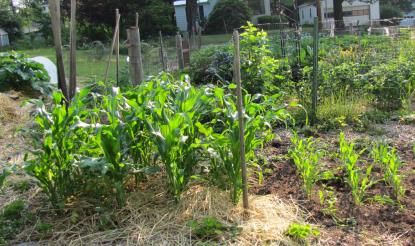
I used to visit my grandfather in Narragansett, RI pretty frequently. In the summer, roadsides were thronged with signs hawking “native sweet corn.” I’m not sure whether their claims to “nativeness” would stand up to the Republican gestapo, as corn was almost undoubtedly developed outside these United States. Even, gasp, before these United States existed.
Corn, or Zea mays, is entirely the product of artificial selection. That is, one cannot go out into the wilds of South America and find native corn growing under a banana tree. Humans developed corn from an ancestor called teosinte. Teosinte makes tiny “ears” that are less than an inch long and nearly inedible. By sowing seeds from plants that showed promise, our great great grand farmers created corn. Farmers capitalized on mutations that just happened. The vast majority of the random mutations do nothing or have deletirious effects. Some taste good. Corn, unlike most crops gets a lot of mutations, so the process moved relatively rapidly.
But our great great grand farmers didn’t create sweet corn– at least not right away. For quite a long time, farmers grew corn for the starch. Dent corn, or mature corn, gets ground into meal. In our debased times we also feed it to livestock even though it tends to give them a tummy ache. At some point before the disease bearing white man invaded, native farmers had isolated another mutation; this one cut down, at least temporarily, the starchiness of corn and made for lovely sweet corn. Normally corn turns the sugars in the kernels into starches pretty quickly.
These carefully selected mutants, then, are the beloved sweet corn that people ate for decades. They didn’t keep well so had to be cooked, canned, frozen or eaten quickly. In the last several decades though new mutations were identified using modern screening techniques (not genetic modification). These mutations led to even sweeter corn. Pointy headed geeks hybridized (made them get naughty with one another) these newly isolated mutations to produce super sweet and sugar enhanced varieties.
Now I don’t want to get too deep in the weeds here but a corn kernel consists of an embryo and an endosperm. The embryo gets half of its DNA from the mom corn and half from the dad corn. It does not affect the flavor of the corn. The endosperm has two copies of mom and one copy of dad and does affect the flavor. The impact of this is that if you mix your varieties in the same area, you can sometimes get corn that’s not sweet at all. So exercise caution Mr/Ms/Dr/Mrs/DVM/Esq gardener.
I’ve planted a variety called Silver Queen purchased from a Mainer seed company that I favor. This is standard white sweet corn. That means it will retain its flavor briefly and I’ll need to start the pot boiling before I go pick the ears. It also means the plants are going to be seven feet tall. Damn I wish I’d read that before planting.


